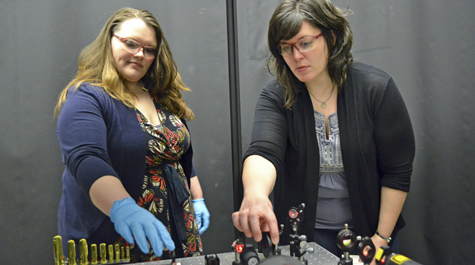Kristin Wustholz named 2018 Henry Dreyfus Teacher-Scholar
William & Mary adds yet another Henry Dreyfus Teacher-Scholar to its ranks as Kristin Wustholz, associate professor of chemistry, was selected as one of eight professors in the nation to receive the coveted award.
The Camille and Henry Dreyfus Foundation, which recognizes chemists who involve undergraduates in their research, announced the winners Friday morning. The Dreyfus Scholar Award comes with an unrestricted $60,000 grant to support “scholarly research with undergraduates, as well as a compelling commitment to teaching.”
"I’m honored and thrilled to be a 2018 Henry Dreyfus Teacher-Scholar," Wustholz said. "Special thanks to the tremendously talented students who made it possible."
Wustholz specializes in using spectroscopic tools to identify materials that make up paints in colonial art. Along with informing her own research and interest in art, her findings have helped curators and conservators inform best practices for conservation science.
She worked with Shelley Svoboda, senior conservator of paintings at the Colonial Williamsburg Foundation, to support attribution of a Cézanne painting first identified by Muscarelle Museum of Art chief curator John Spike. They used the technique SERS — surface enhanced Raman spectroscopy — to bolster Spike’s assertion that the painting was, in fact, an original Cézanne.
A double major in chemistry and philosophy, Wustholz found her passion investigating many elements of color. Wustholz says connecting her research with philosophical, artistic and even historical questions can make chemistry more relatable for her students.
“I think that my mantra involves encouraging and supporting students to follow their gut instinct and to pursue what they love to do,” she said in a 2016 interview. “I was a pretty goofy kid. I like to incorporate my personality into my lectures to show students that I’m human.”
Wustholz is the eighth member of the William & Mary Department of Chemistry to be named a Henry Dreyfus Teacher-Scholars. On the Dreyfus list of awardees dating back to 1994, no other school has more than six. Furthermore, all eight of William & Mary’s Henry Dreyfus Teacher-Scholars are active members of the chemistry faculty.
In addition to Wustholz, the chemistry department has Henry Dreyfus Teacher-Scholars in Doug Young (2017), Jonathan R. Scheerer (2015), Elizabeth Harbron (2010), J.C. Poutsma (2006), Robert Hinkle (2002), Robert D. Pike (1999) and Christopher J. Abelt (1996).
Plus the university has one more: Myriam Cotten, an associate professor in the Department of Applied Science, who became a 2014 Henry Dreyfus Teacher-Scholar at a previous position at Hamilton College.
The Camille and Henry Dreyfus Foundation is a leading non-profit organization devoted to the advancement of the chemical sciences. It was established in 1946 by chemist, inventor and businessman Camille Dreyfus, who directed that the foundation's purpose be "to advance the science of chemistry, chemical engineering and related sciences as a means of improving human relations and circumstances around the world."
"Research support at undergraduate institutions is very important," Mark Cardillo, executive director of The Camille and Henry Dreyfus Foundation said in a release. "Nearly half the chemists who earn a doctorate degree receive their bachelor's degree from an undergraduate institution, and research is a fundamental part of chemistry education."
 Skip to main content
Skip to main content

